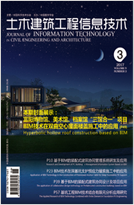2022, 14(5): 103-109. doi: 10.16670/j.cnki.cn11-5823/tu.2022.05.18
基于BIM的室内机器人空气消杀算法设计与仿真
| 1. | 武汉理工大学 土木工程与建筑学院,武汉 430070 |
| 2. | 中国建筑第二工程局有限公司 华东公司,上海 200135 |
Design and Simulation of Indoor Robot Air Disinfection Algorithm Based on BIM
| 1. | School of Civil Engineering and Architecture, Wuhan University of Technology, Wuhan 430070, China |
| 2. | China Construction Second Engineering Bureau Ltd., East China Company, Shanghai 200135, China |
引用本文:
黄榕江, 曾强, 王永生, 刘浩, 罗时朋. 基于BIM的室内机器人空气消杀算法设计与仿真[J]. 土木建筑工程信息技术,
2022, 14(5): 103-109.
doi: 10.16670/j.cnki.cn11-5823/tu.2022.05.18

Citation:
Rongjiang Huang, Qiang Zeng, Yongsheng Wang, Hao Liu, Shipeng Luo. Design and Simulation of Indoor Robot Air Disinfection Algorithm Based on BIM[J]. Journal of Information Technologyin Civil Engineering and Architecture,
2022, 14(5): 103-109.
doi: 10.16670/j.cnki.cn11-5823/tu.2022.05.18

摘要:针对室内空气消杀机器人具有解放劳动力,减小感染风险,消杀工作柔性化、智能化的优点,设计了一套基于BIM的空气消杀算法,确定了机器人消杀工作模式,提取IFC文件构件信息,重构室内模型,改进牛耕分解法式单元分解法实现区域分解,设计区域最佳往复方向,基于可视图的免疫优化算法确定区域间连接路径。仿真实验证明模型及算法的可行性,设计与A*算法的对比,结果表明可视图算法在转移路程、转移用时上更具优势。
Abstract: In view of the advantages of the indoor air disinfection robot, which has the advantages of liberating the labor force, reducing the risk of infection, and making the disinfection work flexible and intelligent, a set of BIM-based air disinfection algorithm is designed, the robot disinfection work mode is determined, and the information of menbers in IFC is extracted. Reconstruct the indoor model, improve the boustrophedon decomposition method to achieve regional decomposition, design the best reciprocating direction of the region, and determine the connection path between regions based on the visual graph and immune optimization algorithm. The simulation experiment proves the feasibility of the model and the algorithm. The comparison between the design and the A* algorithm shows that the visual graph algorithm has more advantages in the transfer distance and transfer time.
| [1] |
刘浩敏, 章国锋, 鲍虎军. 基于单目视觉的同时定位与地图构建方法综述[J]. 计算机辅助设计与图形学学报, 2016, 28(6): 855-868.doi: 10.3969/j.issn.1003-9775.2016.06.001 |
| [2] |
陈超勇, 熊禾根, 陶永, 等. 基于高效模板法与动态窗口法的服务机器人全覆盖路径规划方法[J]. 高技术通讯, 2020, 30(9): 949-958. |
| [3] |
赖华辉, 侯铁, 钟祖良, 等. BIM数据标准IFC发展分析[J]. 土木工程与管理学报, 2020, 37(1): 126-133. |
| [4] |
陈远, 康虹, 张静雅. 基于IFC标准的BIM模型编程语言解析方法研究[J]. 土木建筑工程信息技术, 2017, 9(3): 85-89. |
| [5] |
梁晓辉, 慕永辉, 吴北华, 等. 关于路径规划的相关算法综述[J]. 价值工程, 2020, 39(3): 295-299. |
| [6] |
周林娜, 汪芸, 张鑫, 等. 矿区废弃地移动机器人全覆盖路径规划[J]. 工程科学学报, 2020, 42(9): 1220-1228. |
| [7] |
HUANG W H. Optimal line-sweep-based decompositions for coverage algorithms: Robotics and Automation, 2001. Proceedings 2001 ICRA. IEEE International Conference on[C]. 2001, 27-32. |
| [8] |
刘松, 李志蜀, 李奇. 机器人全覆盖最优路径规划的改进遗传算法[J]. 计算机工程与应用, 2009, 45(31): 245-248. |
| [9] | |
| [10] |
消毒剂使用指南[J]. 中国感染控制杂志, 2020, 19(2): 196-198. |
| [11] |
张雨. 基于IFC空间数据及改进遗传算法的室内机器人路径规划研究[D]. 郑州大学, 2021. |
计量
- PDF下载量(21)
- 文章访问量(1273)
- HTML全文浏览量(848)















